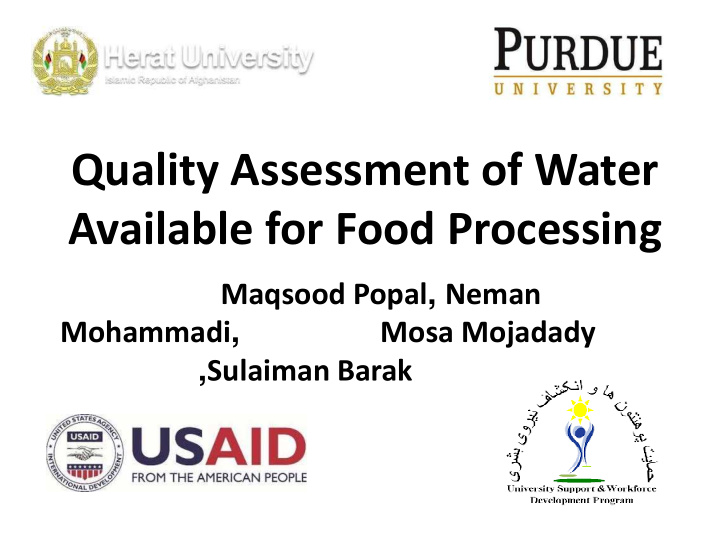



Quality Assessment of Water Available for Food Processing Maqsood Popal , Neman Mohammadi , Mosa Mojadady , Sulaiman Barak
Introduction • Food quality and safety is often dependent on water quality • High quality water is necessary if water is used an ingredient • High quality is also necessary for proper sanitation and hygiene • There are two main sources of water in Herat – Wells – Piped or municipal water
Objective Procedures • Measure the quality of • Collected over 200 water water available in Herat for food processing samples from wells and taps throughout Herat City and – Chemical contaminants the surrounding area • Arsenic • Nitrates/Nitrites • Phosphates • Lead – Biological contaminants • Coliforms • E. coli – Hardness and pH
Materials and Methods
Procedures Several measurements were done using a spectrophotometer: • Phosphate • Nitrate • Nitrite • Arsenic • Lead E. coli and total coliforms were measured using a vacuum/plating technique Concentrations were measured in CFU/mL
Results-General General Water Characteristic. SOURCE pH Hardness Well 7.45 603.9 Tap 7.54 461.1
Results-Microbiology Percentage of water samples above the maximum contamination level. SOURCE E. coli Coliforms Well 27.5 54.6 Tap 20.8 50.6 Samples from both sources frequently tested positive for bacteria
Results-Chemistry Percentage of water samples above the maximum contamination level. SOURCE PO 4 NO 3 NO 2 Pb Arsenic Well 62.2 22.0 4.3 0.0 0.0 Tap 78.8 7.4 2.9 0.0 0.0
Discussion • Herat water is very “hard” containing high amounts of minerals – Not a health concern – May be a concern for equipment • Both types of water frequently contained bacteria – Businesses that rely on water as an ingredient may pursue filtration or other systems
Recommend
More recommend